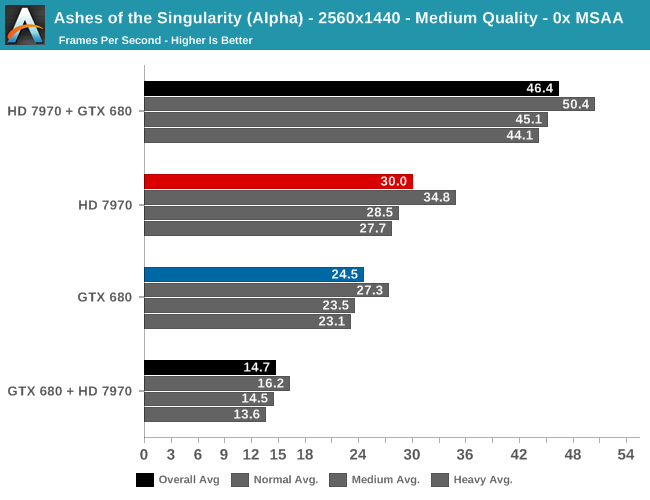GeForce + Radeon: Previewing DirectX 12 Multi-Adapter with Ashes of the Singularity
by Ryan Smith on October 26, 2015 10:00 AM ESTAshes GPU Performance: Single & Mixed 2012 GPUs
While Ashes’ mutli-GPU support sees solid performance gains with current-generation high-end GPUs, we wanted to see if those gains would extend to older DirectX 12 GPUs. To that end we’ve put the GeForce GTX 680 and the Radeon HD 7970 through a similar test, running the Ashes’ benchmark at 2560x1440 with Medium image quality and no MSAA.

First off, unlike our high-end GPUs there’s a distinct performance difference between our AMD and NVIDIA cards. The Radeon HD 7970 performs 22% better here, just averaging 30fps to the GTX 680’s 24.5fps. So right off the bat we’re entering an AFR setup with a moderately unbalanced set of cards.
Once we do turn on AFR, two very different things happen. The GTX 680 + HD 7970 setup is an outright performance regression, with performance 40% from the single GTX 680 Ti. On the other hand the HD 7970 + GTX 680 setup sees an unexpectedly good performance gain from AFR, picking up a further 55% to 46.4fps.
As this test is a smaller number of combinations it’s not clear where the bottlenecks are, but it’s none the less very interesting how we get such widely different results depending on which card is in the lead. In the GTX 680 + HD 7970 setup, either the GTX 680 is a bad leader or the HD 7970 is a bad follower, and this leads to this setup spinning its proverbial wheels. Otherwise letting the HD 7970 lead and GTX 680 follow sees a bigger performance gain than we would have expected for a moderately unbalanced setup with a pair of cards that were never known for their efficient PCIe data transfers. So long as you let the HD 7970 lead, at least in this case you could absolutely get away with a mixed GPU pairing of older GPUs.










180 Comments
View All Comments
LemmingOverlord - Wednesday, October 28, 2015 - link
Now that's what I call ... DRIFT COMPATIBLE!!!!! <cue guitar riff>albert89 - Wednesday, October 28, 2015 - link
Would love to see DX12 multi-adapter work with a gaming card and a workstation card combination. Is it even possible ?wiak - Thursday, October 29, 2015 - link
the reason that amd primary + mvidia is better is pretty much the GCN architecture, GCN has ACE that helps to distribute the work to the secondary nvidia gpuzodiacfml - Friday, October 30, 2015 - link
Not holding my breath on this one. I would be happy though if they can put the integrated GPU to good use.drep - Friday, October 30, 2015 - link
Maybe I missed it somewhere, but does this mean you no longer need the SLI link on your Nvidia cards when using dx12 with these features? I assume you dont can't you cant use a link on the AMD card. Is there a performance difference if you 2 nvidia cards using the SLI link versus if you don't use it in this bench?Oxford Guy - Friday, October 30, 2015 - link
Isn't it the 290X/390X that gets the biggest performance boost from Ashes? It would be nice to have one of those included.gothxx - Saturday, October 31, 2015 - link
@Ryan Smith, what does mixed GPUs mean for G-Sync/Freesync? is it possible to support both just switching which is the primary GPU and in which card the monitor is connected?echtogammut - Monday, November 2, 2015 - link
You can be certain that either AMD or NVidia will kill off this ability with some driver "update".Haravikk - Tuesday, November 3, 2015 - link
Promising stuff.I'm curious actually, but how well (if at all) does DirectX 12/Mantle interact with HSA? Presumably DirectX 12 and Mantle have their own mechanisms for handling memory use, but does either graphics API leverage HSA in systems that have it, or is that still something that developers need to do themselves? I could see that making a difference an APU iGPU + dGPU setup, maybe even more-so if the discrete graphics are also from AMD?
RavenSe - Tuesday, November 3, 2015 - link
Well actually I believe that's one of the best moves for the crowds by MS. Fck branding let them fight together and we gonna take advantage of both anyways.I can see Ryan said he doesn't have a clue how come mixing gets better than keeping one side. Did you look at minimums? I got a simple hunch... how about there is parts of both GPU's that handle specific task worse but since those GPU are so architecturally different, they help each other to handle those bottlenecks. I'm not sure it can work this way but that would be logical... give some task to be done for the card that can handle it better for example PhysX to nVidia and some heavy computing to AMD. This way or another thats actually the first time in my life when I'll start considering having both vendors at once in the same rig!